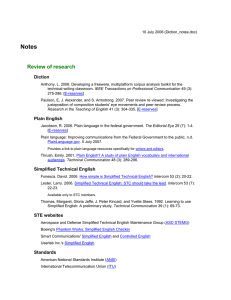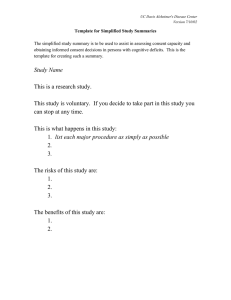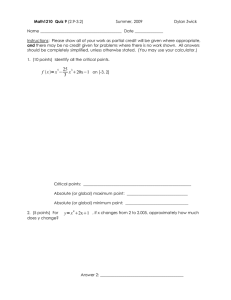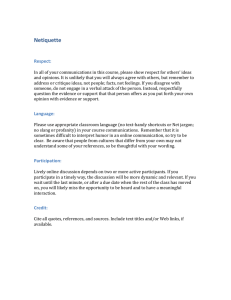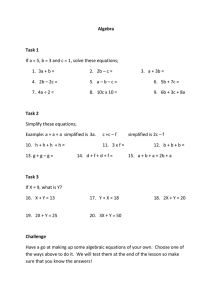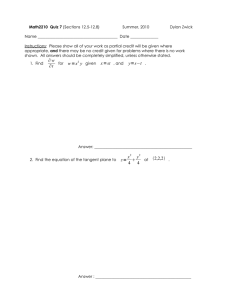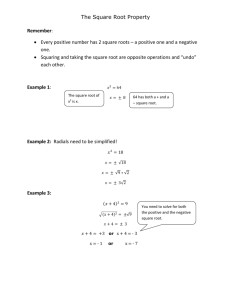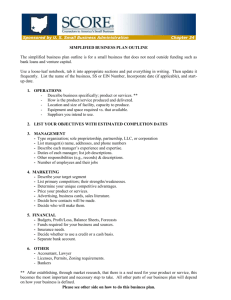Diction notes Review of research Diction
advertisement
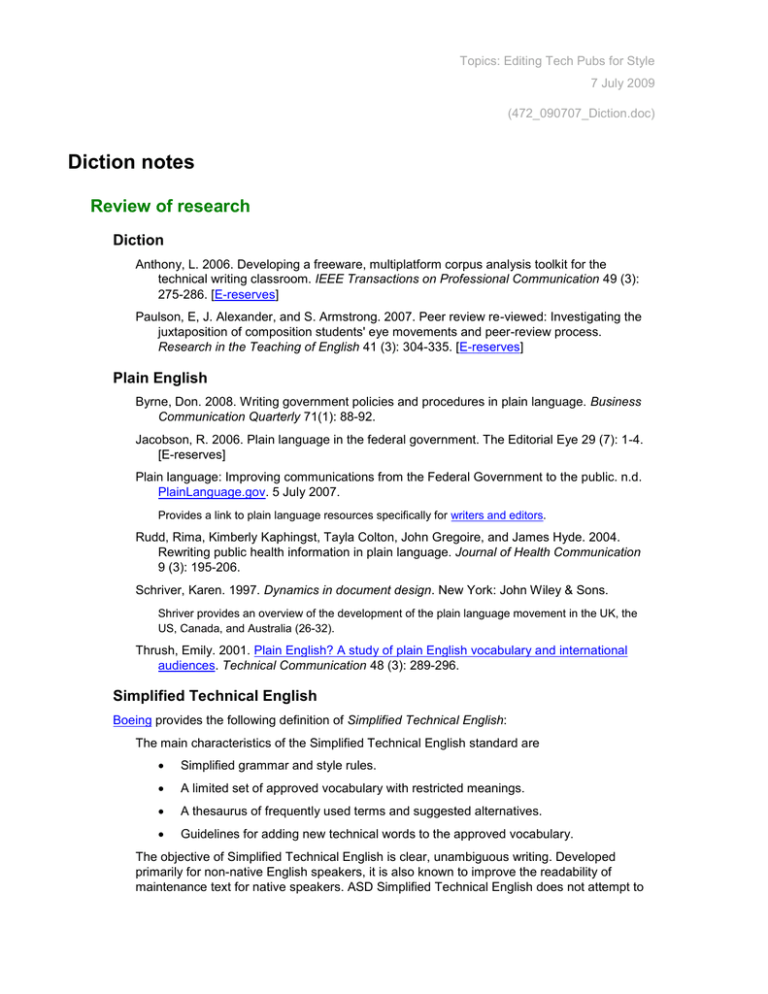
Topics: Editing Tech Pubs for Style 7 July 2009 (472_090707_Diction.doc) Diction notes Review of research Diction Anthony, L. 2006. Developing a freeware, multiplatform corpus analysis toolkit for the technical writing classroom. IEEE Transactions on Professional Communication 49 (3): 275-286. [E-reserves] Paulson, E, J. Alexander, and S. Armstrong. 2007. Peer review re-viewed: Investigating the juxtaposition of composition students' eye movements and peer-review process. Research in the Teaching of English 41 (3): 304-335. [E-reserves] Plain English Byrne, Don. 2008. Writing government policies and procedures in plain language. Business Communication Quarterly 71(1): 88-92. Jacobson, R. 2006. Plain language in the federal government. The Editorial Eye 29 (7): 1-4. [E-reserves] Plain language: Improving communications from the Federal Government to the public. n.d. PlainLanguage.gov. 5 July 2007. Provides a link to plain language resources specifically for writers and editors. Rudd, Rima, Kimberly Kaphingst, Tayla Colton, John Gregoire, and James Hyde. 2004. Rewriting public health information in plain language. Journal of Health Communication 9 (3): 195-206. Schriver, Karen. 1997. Dynamics in document design. New York: John Wiley & Sons. Shriver provides an overview of the development of the plain language movement in the UK, the US, Canada, and Australia (26-32). Thrush, Emily. 2001. Plain English? A study of plain English vocabulary and international audiences. Technical Communication 48 (3): 289-296. Simplified Technical English Boeing provides the following definition of Simplified Technical English: The main characteristics of the Simplified Technical English standard are Simplified grammar and style rules. A limited set of approved vocabulary with restricted meanings. A thesaurus of frequently used terms and suggested alternatives. Guidelines for adding new technical words to the approved vocabulary. The objective of Simplified Technical English is clear, unambiguous writing. Developed primarily for non-native English speakers, it is also known to improve the readability of maintenance text for native speakers. ASD Simplified Technical English does not attempt to Topics: Editing Tech Pubs for Style 30 June 2009 Page 2 define English grammar or prescribe correct English. It does attempt to limit the range of English, and many of its rules are recommendations found in technical writing textbooks. For example, SE requires writers to Use the active voice. Use articles wherever possible. Use simple verb tenses. Use language consistently. Avoid lengthy compound words. Use relatively short sentences. Controlled English for global documentation. n.d. Technical English Services. Dow Douglas. 25 October 2007. Simplified Technical English: What’s in it for us? [ppt] STC India Annual Conference. Fonesca, David. 2006. How simple is Simplified Technical English? Intercom 53 (2): 20-22. Lester, Larry. 2006. Simplified Technical English: STC should take the lead. Intercom 53 (7): 22-23. Available only to STC members. Thomas, Margaret, Gloria Jaffe, J. Peter Kincaid, and Yvette Stees. 1992. Learning to use Simplified English: A preliminary study, Technical Communication 39 (1): 69-73. STE websites Aerospace and Defense Simplified Technical English Maintenance Group (STEMG) Boeing's Phantom Works: Simplified English Checker Simplified english-aecma.org European Association of Aerospace Industries (AECMA) Simplified English rules and vocabulary. n.d. Scribd Simplified Technical English – ASD-STE100 (Shufra) Smart Communications' Simplified English and Controlled English Userlab Inc.'s Simplified English Topics: Editing Tech Pubs for Style 30 June 2009 Page 3 Standards American National Standards Institute (ANSI) International Telecommunication Union (ITU) International Organization for Standardization (ISO) National Institute of Standards and Technology (NIST) Jones’ Technical Writing Style The following vocabulary and list of writing styles were taken from Chapters 5–6 of Jones’ Technical Writing Style. All page references are to his text. Vocabulary You are responsible for the following vocabulary: Diction – four levels are formal, informal, colloquial, and slang appropriateness – clarity – conciseness – concreteness – consistency – simplicity – sincerity – Connotation – Denotation – Homonyms – Homographs – Homophones – Synonyms – Nounce words – Expletives – Solecisms – Literary style – alliteration – anthropomorphizing – assonance/consonance – elegancies and literarisms – Topics: Editing Tech Pubs for Style 30 June 2009 Page 4 figures of speech – similes, metaphors, personification, hyperbole, and understatement Euphemisms – Dysphemisms – Abbreviations – acronyms – TLA, TLAs, ETLA, SFLA, YABA (Foldoc) As of 2003-11-10, Foldoc gave expansions for 1218 out of the 26^3 = 17576 possible TLAs. initialisms – A SQL server vs. an SQL server? By the way, the correct pronunciation of SQL is a contentious issue within the database community. In their SQL standard, the American National Standards Institute declared that the official pronunciation is "es queue el." However, many database professionals have taken to the slang pronunciation "sequel." The choice is yours. (SQL Fundamentals, About.com) SQL was developed at IBM by Andrew Richardson, Donald C. Messerly and Raymond F. Boyce in the early 1970s. This version, initially called SEQUEL, was designed to manipulate and retrieve data stored in IBM's original relational database product, System R. (Wikipedia) Common diction faults Jones identifies the following common diction faults: archaic words/dialect/colloquialisms – bloopers/vulgarism/taboo words/barbarisms – catchword/catchphrase/vogue words – clichés – clipped words/contractions – commonly confused words/confusibles/suggestibles – double negatives foreign words and phrases/Latin abbreviations – idioms – ‘izing”/nominalizations/verbizing/-wise words – logic trap words/meaningless words/totality words/vagueness/wooliness – legal terms/overuse of prepositional phrases modifiers/noun phrases/noun strings – negative words and phrases/negative instructions – neologisms/nonsense words – redundancy/repetition/tautology/expletives – sexist and discriminatory languge – Topics: Editing Tech Pubs for Style 30 June 2009 Page 5 solecisms/improprieties – Specialized languages Jones identifies the following specialize languages: jargon – occupational slang, professional/technical terminology, technical metaphors, buzzwords, doublespeak, abbreviations, and ex-jargon slang – cant and argot – doublespeak – euphemism, jargon, gobbledygook (or bureaucratese), and inflated language tech speak – technobabble and computerese – shop talk – Quiz You have 15 minutes for this quiz. You may use your texts; however, if you do quote, paraphrase, or summarize information from any of your texts, please cite the source (title and page parenthetically). Please write as much as you can as quickly as you can. 1. Distinguish between plain language and simplified technical English. How are they similar? How are they different? 2. What is AntConc? What appear to be its greatest benefits and drawbacks? 3. What role does diction/vocabulary play in readability formulas? Exercises—Plain language The following examples are taken from the PlainLanguage.gov website. EXAMPLE 1 Before Right of use means any authorization issued under this part that allows use of Outer Continental Shelf lands. Your revision After Right of use means any authorization under this part to use Outer Continental Shelf lands. Topics: Editing Tech Pubs for Style 30 June 2009 Page 6 EXAMPLE 2 Before This regulation governs disaster assistance for services to prevent hardship caused by fire, flood, or acts of nature that are not provided by FEMA or the Red Cross. Revision After This regulation governs disaster assistance that (a) consists of services to prevent hardship caused by fire, flood, or acts of nature; and (b) is furnished by a provider other than FEMA or the Red Cross. EXAMPLE 3 Before This rule proposes the Spring/Summer subsistence harvest regulations in Alaska for migratory birds that expire on August 31, 2003. Revision After This rule proposes the Spring/Summer subsistence harvest regulations for migratory birds in Alaska. The regulations will expire on August 31, 2003 Exercise—E-prime Robert Wilson has written a brief primer on E-prime, which encourages us to eliminate existential uses of the verb be (modifying those uses of the verb be in sentences of the pattern SubjectVerb-Complement). Wilson, Robert Anton. n.d. Toward understanding E-prime. NoBeliefs.com <http://www.nobeliefs.com/eprime.htm> 14 October 2005. Note how I have replaced be in the following sentences: The result of such editing or rewriting is almost always a longer and livelier sentence. Such editing or rewriting typically results in a longer and livelier sentence. Buffy is a student. Buffy has attended MSU since 2002. Biff is sleepy. Biff can barely stay awake. Do not confuse the existential use of be with the use of be as an auxiliary verb in progressive and passive verb phrases. Topics: Editing Tech Pubs for Style 30 June 2009 Page 7 Buffy is taking three courses this semester. Biff was diagnosed with narcolepsy. With E-prime, you are primarily concerned with the various forms of the verb be; however, I would encourage you to extend your concern to all linking verbs—those which produce the following sentence pattern: S V C. The most common linking verbs are be seem look become appear taste sound feel smell Advocates of E-prime accept the substitution of appears for be as in the following example: The bicycle is red. The bicycle appears red. But most of us would claim that the speaker or writer of those two sentences has very different purposes for using one rather than the other—that the sentences are not synonymous in locution, illocution, or perlocution. Following the examples above, revise the following sentences: 1. Biff is a student. 2. Jay was giddy. 3. The frog is green. 4. The meat tastes salty. 5. Buffy is a botanist. 6. What you see is what you get. 7. Cheating seems wrong. 8. Lutefisk is my favorite food. D2L small-group assignment Please complete the following tasks: 1. TWS, Chapter 5, Exercise 7, page 114. Read the following two paragraphs concerning the presentation program PowerPoint. characterize the appropriateness of the word choices and the conciseness of the prose: Whether presentations help you deliver company results to a shareholders’ meeting or report sales figures at a hastily scheduled business meeting, they play a major role in how business people communicate. Microsoft PowerPoint for Windows 95, the leader in presentation graphics software, has all the tools you’ll need to put together professional, compelling presentations quickly and easily. Topics: Editing Tech Pubs for Style 30 June 2009 Page 8 Microsoft PowerPoint for Windows 95 Step by Step is a comprehensive tutorial that shows you how to use PowerPoint to create professional looking presentations. Working through this book you’ll learn about the different presentation materials PowerPoint helps you create: slides, overheads, audience handouts, presentation outlines, speaker’s notes, and electronic presentations that show on your computer. You’ll discover the basic building blocks that make up dynamic slides, including eyecatching clip art, easy-to-use text tools that let you create and format text, drawing tools the [sic] help you create interesting shapes and effects, and special tools that help you import information from other sources, such as charts, graphs, tables, picture, sounds, and movies. This book also teaches you how to find the help you need from PowerPoint’s useful aids such as online Help, tips, and wizards. Response: 2. TWS, Chapter 6, Exercise 12, pages 140-141 Highlight (in yellow) your characterization of the word choices; then, complete the justification for your choice. Example 1 – jargon, slang, shoptalk, argot, or ? because Example 2 – jargon, slang, shoptalk, argot, or ? because Example 3 – jargon, slang, shoptalk, argot, or ? because Example 4 – jargon, slang, shoptalk, argot, or ? because Example 5 – jargon, slang, shoptalk, argot, or ? because
